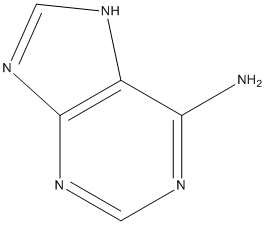All AbMole products are for research use only, cannot be used for human consumption.

Adenine is a purine derivative and a nucleobase with a variety of roles in biochemistry including cellular respiration, in the form of both the energy-rich adenosine triphosphate (ATP) and the cofactors nicotinamide adenine dinucleotide (NAD) and flavin adenine dinucleotide (FAD), and protein synthesis, as a chemical component of DNA and RNA. The shape of adenine is complementary to either thymine in DNA or uracil in RNA. Adenine is one of the two purine nucleobases (the other being guanine) used in forming nucleotides of the nucleic acids. In DNA, adenine binds to thymine via two hydrogen bonds to assist in stabilizing the nucleic acid structures. In RNA, which is used for protein synthesis, adenine binds to uracil. Adenine forms adenosine, a nucleoside, when attached to ribose, and deoxyadenosine when attached to deoxyribose. Adenine forms adenosine triphosphate (ATP), a nucleotide, when three phosphate groups are added to adenosine. Adenosine triphosphate is used in cellular metabolism as one of the basic methods of transferring chemical energy between chemical reactions.
| Molecular Weight | 135.13 |
| Formula | C5H5N5 |
| CAS Number | 73-24-5 |
| Solubility (25°C) | DMSO 15 mg/mL 1M HCl 20 mg/mL |
| Storage | 2-8°C |
| Related Animal Modeling Products |
|---|
| 3,4-Benzopyrene
3,4-Benzopyrene shows lung carcinogenicity in animal models. |
| Sodium Thioglycolate
Sodium thioglycolate acts as reducing agent and is suitable for anaerobic and microaerophilic bacterial growth. Sodium thioglycolate is a commonly used reagent for bacteriological research to maintain reducing conditions in media. Thioglycolate can also protect enzymes against inactivation by maintaining protein thiol groups in the reduced state. Thioglycolate medium is frequently used in inflammation research to elicit a neutrophil and macrophage response in vivo. |
| Vancomycin-d10 2TFA salt
Vancomycin-d10 2TFA salt |
| Acetic acid-d4
Acetic acid-d4 |
| Myosin H Chain Fragment, mouse acetate
Myosin H Chain Fragment, mouse acetate salt is a fragment of the α-Myosin heavy chain peptide. Myosin H Chain Fragment can be used to induce experimental autoimmune myocarditis (EAM) mouse model. |
All AbMole products are for research use only, cannot be used for human consumption or veterinary use. We do not provide products or services to individuals. Please comply with the intended use and do not use AbMole products for any other purpose.


Products are for research use only. Not for human use. We do not sell to patients.
© Copyright 2010-2024 AbMole BioScience. All Rights Reserved.
